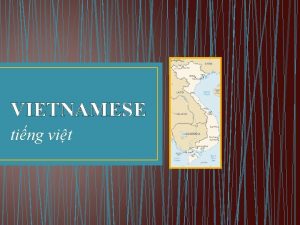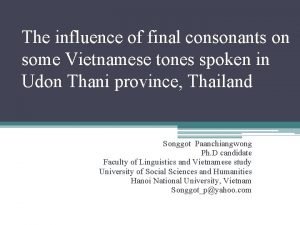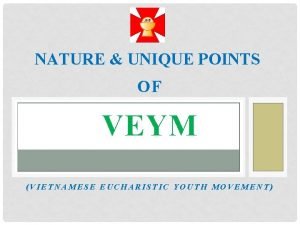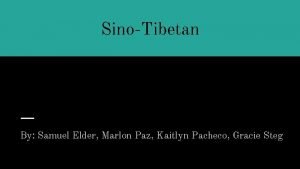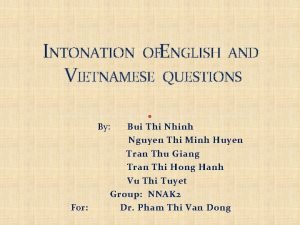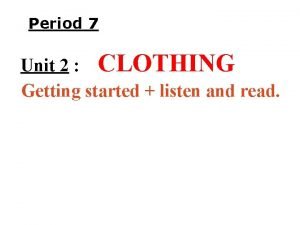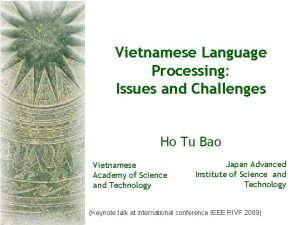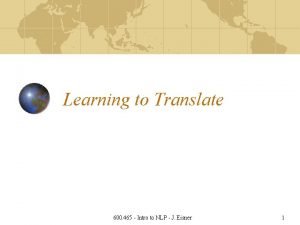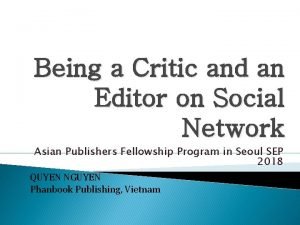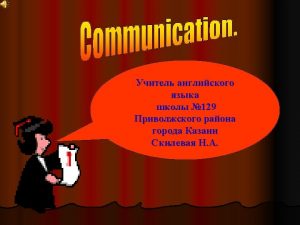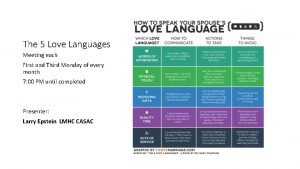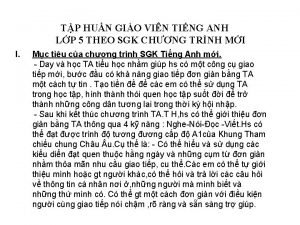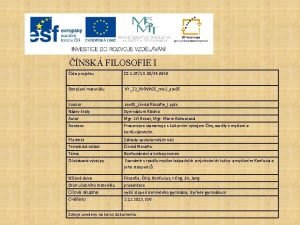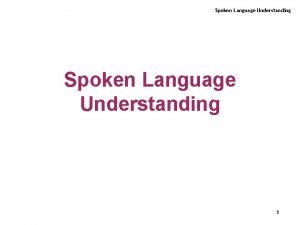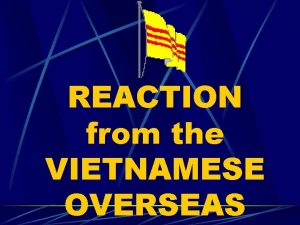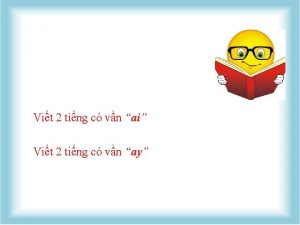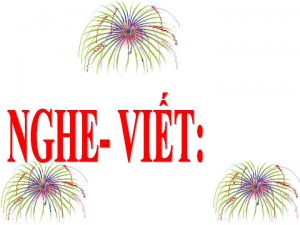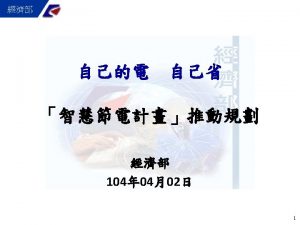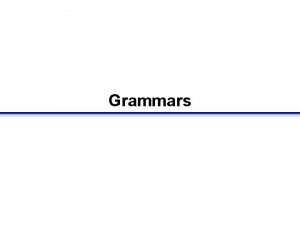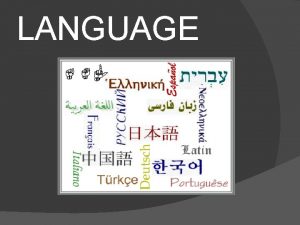VIETNAMESE ting vit There are 103 languages spoken






![8 final consonants § /m/ e. g) em [em] (younger sister/brother) § /n/ e. 8 final consonants § /m/ e. g) em [em] (younger sister/brother) § /n/ e.](https://slidetodoc.com/presentation_image_h/35ec540682365800255606b95ccf8b57/image-7.jpg)
![/k / 1)/ k / [ k + p ] (bilabialised) / [-consonantal, +round] /k / 1)/ k / [ k + p ] (bilabialised) / [-consonantal, +round]](https://slidetodoc.com/presentation_image_h/35ec540682365800255606b95ccf8b57/image-8.jpg)
![/ŋ/ 1)/ŋ/ [ŋ+m] (bilabialised) / [-consonantal, +round] _______ e. g. , ) Xong [soŋ+m] /ŋ/ 1)/ŋ/ [ŋ+m] (bilabialised) / [-consonantal, +round] _______ e. g. , ) Xong [soŋ+m]](https://slidetodoc.com/presentation_image_h/35ec540682365800255606b95ccf8b57/image-9.jpg)





















- Slides: 30

VIETNAMESE tiếng việt

• There are 103 languages spoken in Vietnam. • For 20% of the Vietnamese people, Vietnamese is their second language. • 3 millions overseas speakers of Vietnamese (1/3 of those in America). • Vietnamese is the 7 th most spoken language in the world. The Language vs. The Country

Overview of the Language • Vietnamese is part of the Austro-Asiatic language family. • Heavily influenced by it history with China and France. • Chinese was the official spoken and written language in Vietnam just under 400 years ago. VOCABULARY • As a byproduct of French-colonial rule, many examples of French influence can be found in the language. VOCABULARY • The present writing system: • • Written with the Latin alphabet The 26 letters of the English alphabet minus f, j, w, and z. Seven modified letters using diacritics: ᵭ, ă, ȃ, ȇ, ȏ, ȍ, and ȕ Developed by Portuguese Jesuit missionaries in the 17 th century.

Phonetics/Phonology VIETNAMESE

Phonology / Phonetics § A study of sounds in a language § Vowels & Consonants § 21 initial consonants & 8 final consonants

Restriction on final sounds Only a limited number of sounds can be final consonants in Vietnamese 6 consonants & 2 glides. (/w/, /j/ ) Stop(without aspiration) Nasal Bilabial Alveolar Velar p t k m n ŋ § What words are you hearing? Case Pencil
![8 final consonants m e g em em younger sisterbrother n e 8 final consonants § /m/ e. g) em [em] (younger sister/brother) § /n/ e.](https://slidetodoc.com/presentation_image_h/35ec540682365800255606b95ccf8b57/image-7.jpg)
8 final consonants § /m/ e. g) em [em] (younger sister/brother) § /n/ e. g) phiên [fien] (turn) § /p / e. g) úp [up ] (up-side-down), tiêp [tiep ] (continue) § /t / e. g) giêt [iet ] (kill), ghêt [gεt ] (hate) §/k /, /ŋ/ §Allophones : Allophones are segments that are phonetically distinct but phonologically the same. To define as allophones of one morpheme, they should be distributed complementarily, that is each of them never occurs in the same environment.
![k 1 k k p bilabialised consonantal round /k / 1)/ k / [ k + p ] (bilabialised) / [-consonantal, +round]](https://slidetodoc.com/presentation_image_h/35ec540682365800255606b95ccf8b57/image-8.jpg)
/k / 1)/ k / [ k + p ] (bilabialised) / [-consonantal, +round] _____ e. g. , ) côc [kok + p ] (glass, cup) nhuc [Jok + p ] (insulted) 2)/ k / [c ] (becomes a pre-velar sound, palatalization) / [ front vowels such as i, e, or ε ] _____ e. g. , ) lêch [lic ] (askew) sâch [sεc ] (book) 3)/ k / [ k ]/elsewhere e. g. , ) nhâc [Jak ] (lazy) búc [bʌk ] (angry)
![ŋ 1ŋ ŋm bilabialised consonantal round e g Xong soŋm /ŋ/ 1)/ŋ/ [ŋ+m] (bilabialised) / [-consonantal, +round] _______ e. g. , ) Xong [soŋ+m]](https://slidetodoc.com/presentation_image_h/35ec540682365800255606b95ccf8b57/image-9.jpg)
/ŋ/ 1)/ŋ/ [ŋ+m] (bilabialised) / [-consonantal, +round] _______ e. g. , ) Xong [soŋ+m] (finish), sung [suŋ+m] (gun) 2)/ŋ/ [ŋn] (becomes a pre-velar sound) / [ front vowels such as i, e, and ε ] ______ e. g. , ) benh [beŋn] (sick) tinh [tiŋn] (love) 3)/ŋ/ [ŋ] / elsewhere e. g. , ) tâng [tâŋ] (give)

2 Semi-vowels (Glides) §/w/: it appears in forms of letters “u” or “o” which allow vowels to make diphthongs or triphthongs. dau [daw] (hurt), vào [vaw] (enter) §/j/: it appears in forms of “I” or “y” and is preceded by vowels to make diphthongs or triphthongs. tay [taj] (hand)

Interesting Point § The difference in word-final sound in Vietnamese and English prevents Vietnamese students from pronouncing some English words correctly. L 1 interference: when a person’s knowledge of their native language affects, interferes with, or impedes the use or acquisition of their second language.

Morphology VIETNAMESE

What kind of language is Vietnamese? • Isolating/Analytic: low morpheme-per-word ratio As seen in many languages in Southeast Asia Vietnamese does not have morphological markings for: • case • gender • number • tense …which means Vietnamese has no bound inflectional morphology.

Vocabulary • Much of the Vietnamese vocabulary is borrowed from Chinese (60% with Chinese roots not including Sino-Vietnamese words) • As a result of colonial rule, there is also influence from French in borrowed words such as: cake – ga to cheese – pho mat zipper – phẹc mỏ tua

Morphemes and Syllables • Most Vietnamese morphemes consist of only one syllable i. e. cơm “cooked rice”, but there are words with more than just one i. e. dưa chuột “cucumber. ” • Polymorphemic words are either compounds of words consisting of stems, affixes, or reduplicates. • Vietnamese is NOT a “monosyllabic” language – 80% is disyllabic due to derivation, and polysyllabic morphemes tend to be borrowings

Word Formation Reduplication • increases/decreases intensity • literary device Examples of reduplication increasing intensity: lắm → lắm: very → very much ầm → ầm ầm: noisy → rumble, roar Examples of reduplication decreasing intensity: nhẹ → nhè nhẹ: soft → less soft xinh → xinh: pretty → cute

Word Formation Compounding máy bay machine fly N + V ‘airplane’ xe đạp vehicle pedal N + V ‘bicycle ăn uống eat drink V + V ‘eat and drink’ hòa thuận peaceful agree A + A ‘to be in accord’

Word Formation Affixation - limited with prefixes and suffixes -gia (家) “profession” chính trị gia “politician” khoa học gia “scientist” phi- (不)“not” phi nghĩa “unethical” phi chính phủ “non-governmental”

SYNTAX VIETNAMESE

Basic Syntactic Features • SVO • Head-initial

Daisuke is a student. Daisuke la mot sinh vien. Daisuke is a student

Is Daisuke a student? Daisuke là một sinh viên? Daisuke is a student ? ?

Daisuke likes studying. Daisuke thich hoc hanh. Daisuke like study

Does Daisuke like studying? Daisuke co thich hoc hanh khong? Daisuke have like study no

What does Daisuke like? Daisuke thich gi? Daisuke like what

studying. Matthew biet rang Daisuke thich hoc hanh. Matthew know that Daisuke like study

Interesting Point • No Wh- or I to C movements e. g. , What does Daisuke like? Daisuke say me gi? Does Daisuke like studying? Daisuke co thich hoc hanh khong?

Interesting Point • Four ways of constructing question sentences Is Daisuke a student? 1. Daisuke la mot sinh vien? (written) 2. Daisuke la mot sinh vien, phai khong? 3. Co phai, Daisuke la mot sinh vien khong? 4. Daisuke co phai la sinh vien khong?

PH O Conclusion

Thank you for listening. Have a good day!
 Du maitre qui m'appelle
Du maitre qui m'appelle What language is spoken in vietnam
What language is spoken in vietnam Mikael ferm
Mikael ferm Languages spoken in india
Languages spoken in india Languages in africa
Languages in africa Languages spoken in monaco
Languages spoken in monaco Text summarization vietnamese
Text summarization vietnamese A vietnamese boy names van is living with the parker family
A vietnamese boy names van is living with the parker family Text summarization vietnamese
Text summarization vietnamese Veym
Veym Language in malay
Language in malay The u.s. evacuated vietnamese _____.
The u.s. evacuated vietnamese _____. Vietnamese intonation
Vietnamese intonation Vietnamese women prefer to wear modern clothing
Vietnamese women prefer to wear modern clothing Natural language processing vietnamese
Natural language processing vietnamese Text summarization vietnamese
Text summarization vietnamese Paraphrasing tool vietnamese
Paraphrasing tool vietnamese Translate english vietnamese
Translate english vietnamese Translate english to vietnamese
Translate english to vietnamese Vietnamese government
Vietnamese government How many languages are there
How many languages are there How many different sign languages are there
How many different sign languages are there Dofferent types of love language
Dofferent types of love language Fei protocal
Fei protocal Vin ting
Vin ting Ting task
Ting task Uu ee uu aa ting tang
Uu ee uu aa ting tang Little britain fish and chips
Little britain fish and chips Cykel bestämd form
Cykel bestämd form Vestecka kniha i-ting
Vestecka kniha i-ting Philia sofia
Philia sofia

